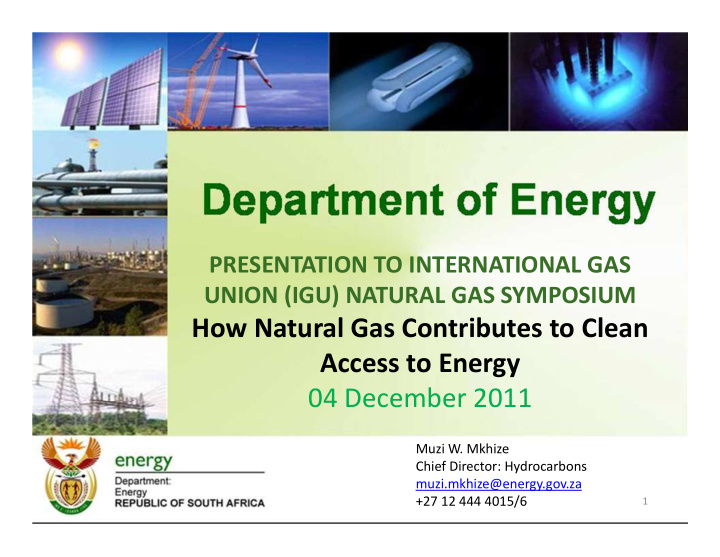



PRESENTATION TO INTERNATIONAL GAS UNION (IGU) NATURAL GAS SYMPOSIUM How Natural Gas Contributes to Clean Access to Energy 04 December 2011 Muzi W. Mkhize Chief Director: Hydrocarbons muzi.mkhize@energy.gov.za +27 12 444 4015/6 1
KEY ISSUES Access o Natural endowment and sourcing • Effective markets • Infrastructure – linking supply and demand • Pipelines (where a large market is less than 3000 km from the resource) • Liquefied natural gas (LNG) – long term contracts for gas help finance the infrastructure • For countries like the USA, Europeans states and Japan the drivers for natural gas usage: o Strategic diversification of energy resources (initially driven by the 1970’s oil crises) • The need for domestic space heating • A clean fuel resource (compared to coal and oil) – a relative cleanliness • The reluctance from the 1980s to commission nuclear power stations (except for countries like France) • All gas sources o Conventional Gas • Unconventional gas – CBM, shale gas; hydrates - natural gas trapped in a water-like state, known to exist in many places on the ocean floor • Pockets of gas – landfill gas, etc • Convergence of energy carriers o “Horses for courses” • Promotion of carriers; • Appliances and switching costs; o Comprehensive Legal and Regulatory Framework o Regulatory certainty; and • Permitting • IGU is a worldwide non ‐ profit organisation, founded in 1931, registered in Vevey, Switzerland with the present Secretariat located in Oslo, Norway. It has 74 Charter members and 35 Associate members in 73 countries, of which South Africa is one. The objective of IGU is to promote the technical and economic progress of the gas industry. 2
SOUTH AFRICAN CONTEXT o Exploration - Mainly offshore and regulated by PASA i.t.o. the MPRDA RSA has very limited gas resources – ~3% of total primary energy consumption • South Coast : FO field development for indigenous gas as feedstock for PetroSA’s • GTL refinery in Mossel Bay West Coast: Development of Ibhubesi Gas Field by Forest Oil in partnership with • PetroSA; developments on blocks north and south of Ibhubesi by PetroSA Jury still out on shale gas potential: estimated ~485 trillion cubic feet (tcf) by the USA • Energy Information Administration o Natural Gas Trade Agreements with Mozambique and Namibia 120 million GJ/a annum gas from Pande and Temane gas fields to CTL refinery in • Secunda From Secunda methane rich gas supplies commercial customers in KwaZulu Natal • Displacement of more polluting resources: coal and heavy fuel oil • Gas Compression Station in Komatipoort commissioned in 2009 - Increase gas flow • rate to 147 million GJ/a Recent gas find in Mozambique augurs well for the region and RSA in particular • Kudu gas in Namibia still being investigated • Noted: reported gas finds in Tanzania estimated to be ~11 tcf • Intra ‐ regional trade in the context of ultimately improving intra ‐ African trade . 3
SOUTH AFRICAN CONTEXT (contd.) Establishment of a National Energy Regulator in 2005: Piped Gas Regulator within NERSA o Integrated Energy Planning is Key o White Paper of Energy Policy – security of energy supply through a diversified energy mix • National Energy Act – Energy planning matters and establishment of SANEDI • Twenty year liquid fuels infrastructure Roadmap • Collaboration among various government institutions, NGOs and private sector players • IRP 2010 - presents a 20-year view on South Africa’s energy (new electricity generation) mix o Seeks to balance growth in demand with South Africa’s commitments to reducing its dependence on coal and to reducing • climate-changing emissions Ensuring security of electricity supply, as well as diversifying the mix away from coal and towards renewable sources and • nuclear energy New electricity generation: imported gas ~ 6%, hydro power 6%, open-cycle gas turbines (OCGTs) 9%, coal 15% and • nuclear 23%: new gen from gas ~15% Re-gasification terminal for LNG imported into the port of Ngqurha for a power plant and other clients in the region • Augmenting indigenous gas for the NOC’s GTL refinery in Mossel Bay • Amendment of the Gas Act o Amongst other things, unambiguously incorporate LNG and CNG • Independent System and Market Operator (ISMO) Bill o Will inter alia, facilitate the participation of independent power producers (IPPs) in electricity generation • Relevance to the PESTEL dynamics o Economic empowerment of historical disadvantaged South Africans (HDSA) • Challenges of Unemployment and poverty; gap between rich and poor; MDGs • Collaboration among key gas industry stakeholders as well as Government is vital to ensure that there is investment in the supporting infrastructure, skills development, improved local content and supplier development that is alive to our socio ‐ economic imperatives . Developing countries need to learn from concerted efforts of Europeans and Americans in creating an infrastructure of interconnected pipelines beyond political boarders. 4
Ngiyabonga kakhulu Thank you Ke a leboha Spasibo Asante sana Shukran gazilan Merci beacoup Muito obrigado Mucho gracias Vielen dank! Tusen takk 5
Recommend
More recommend